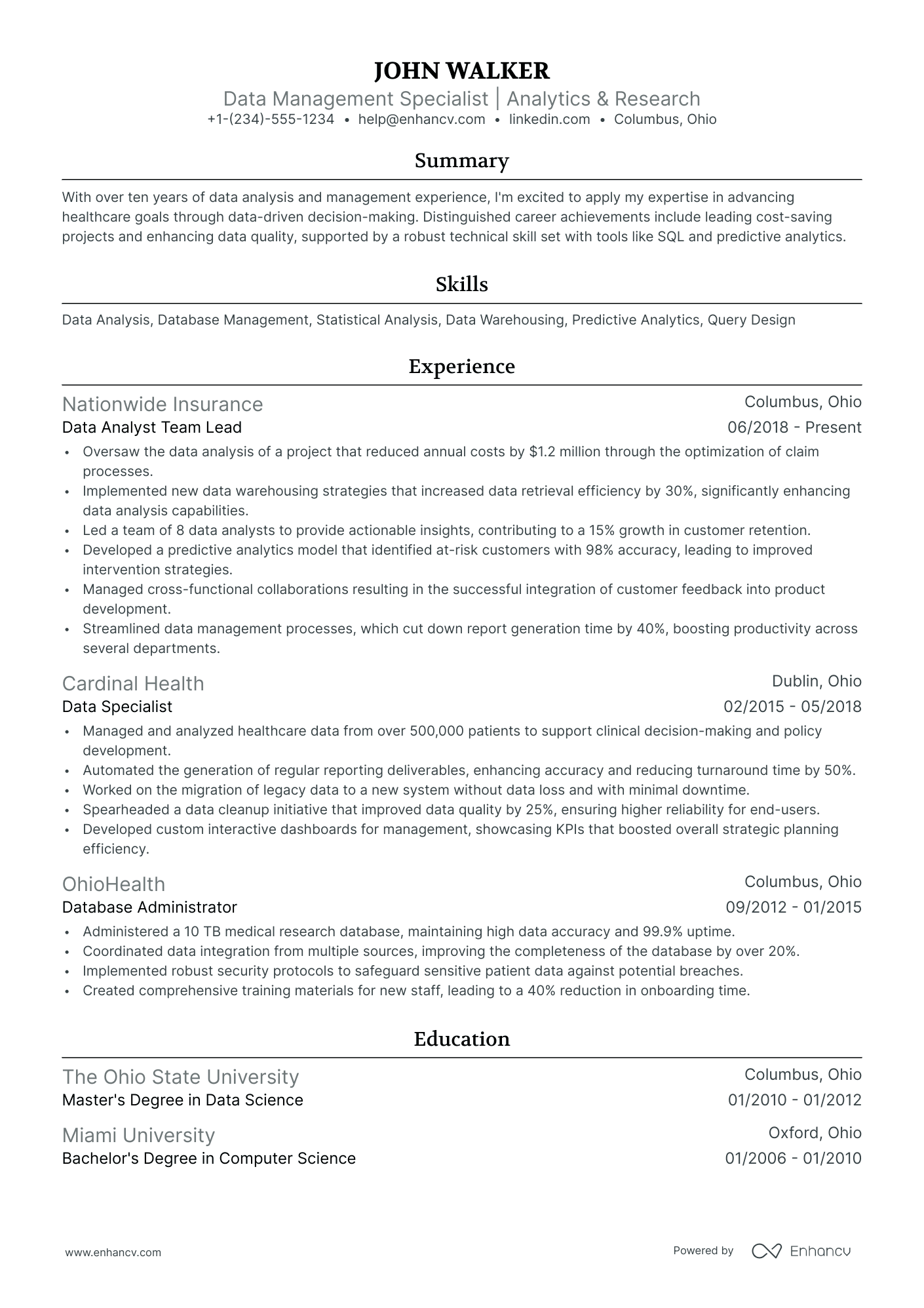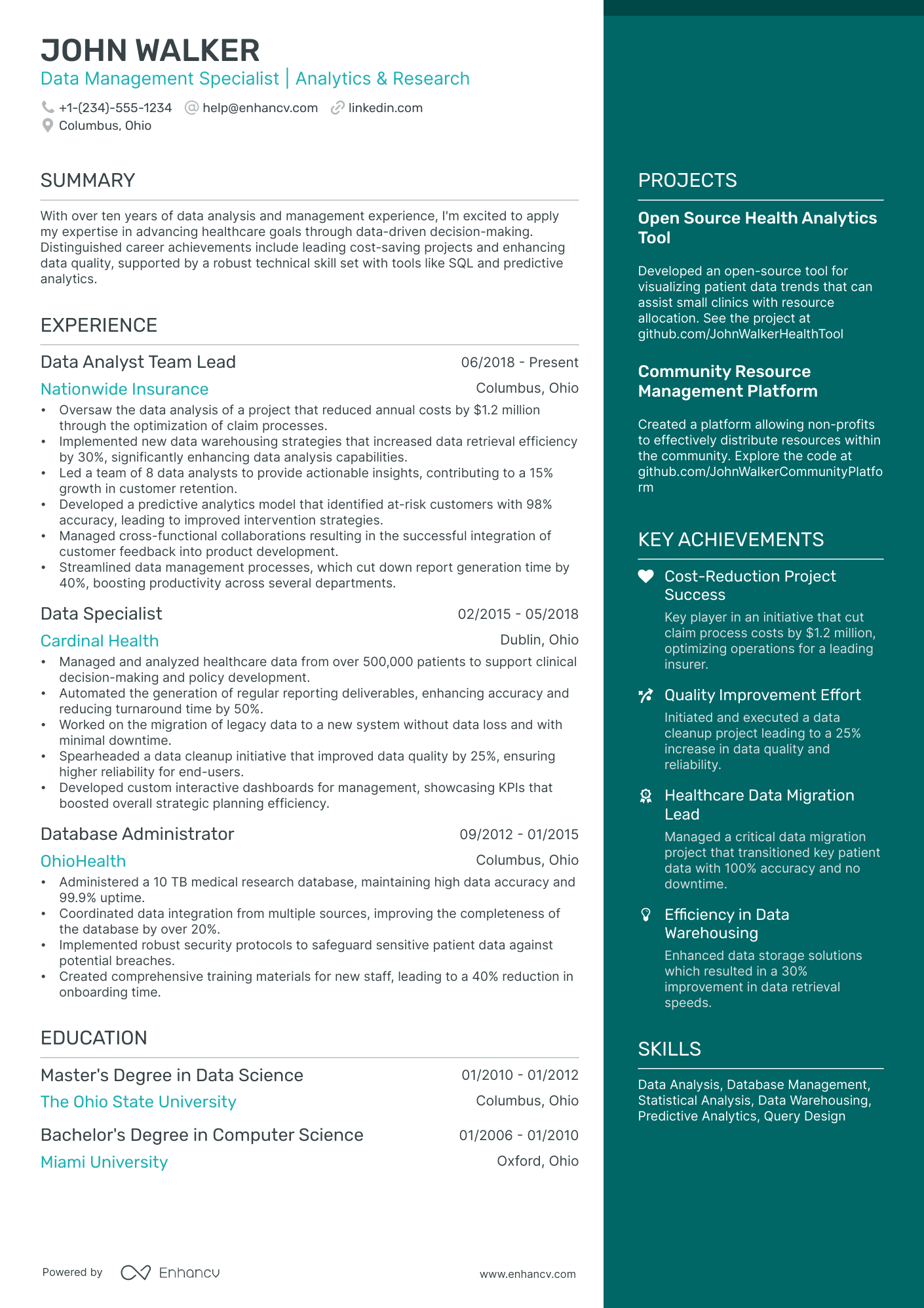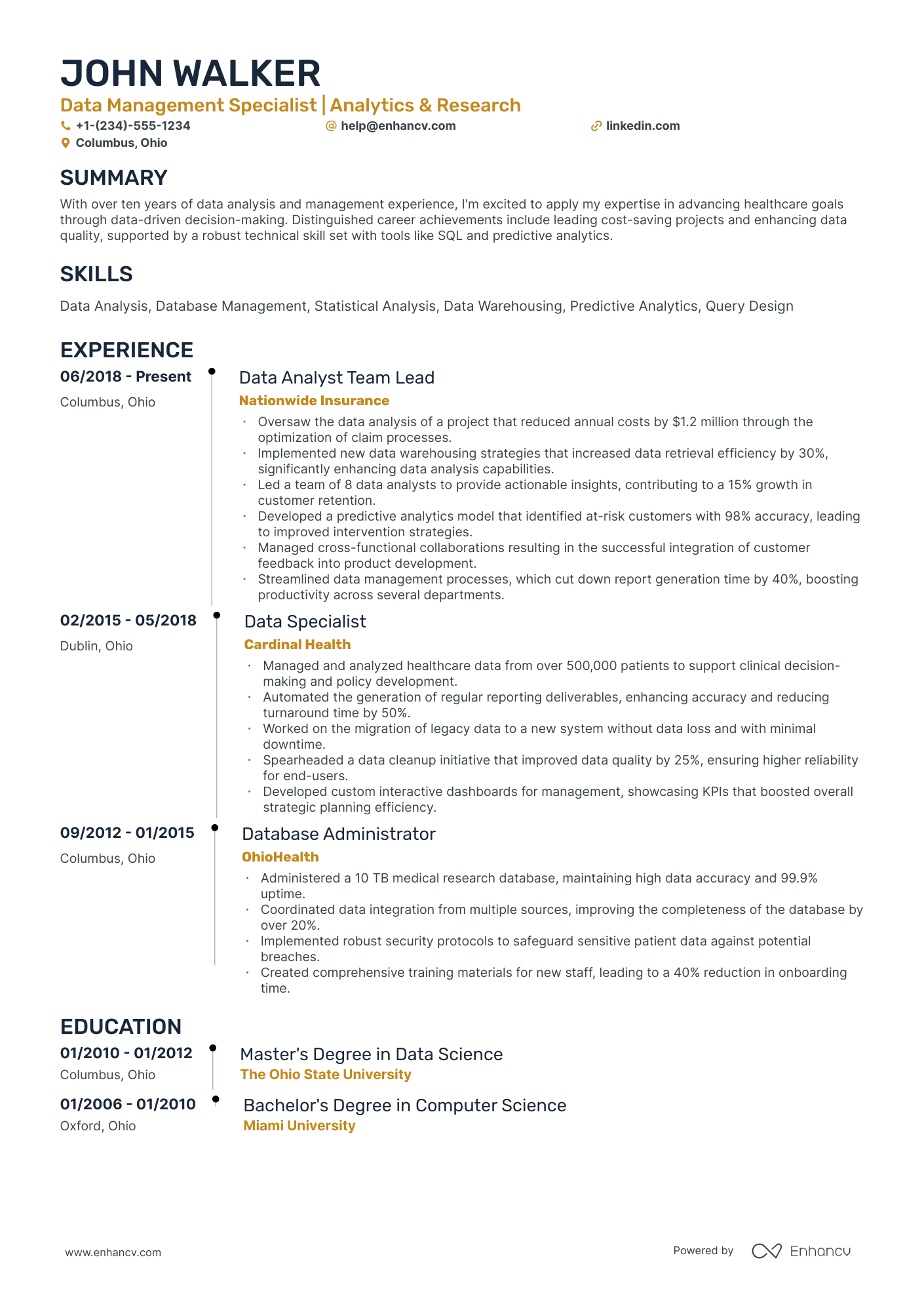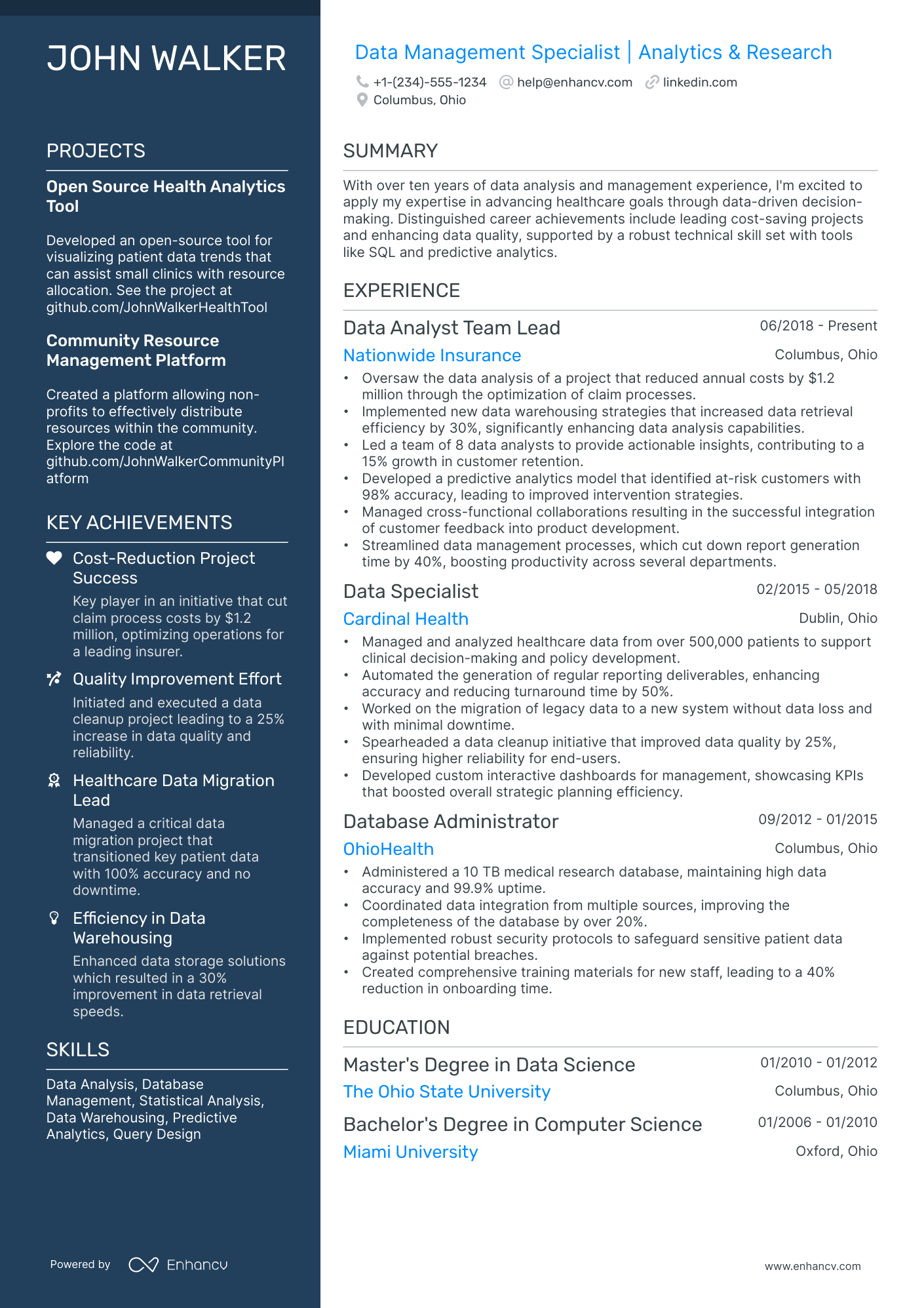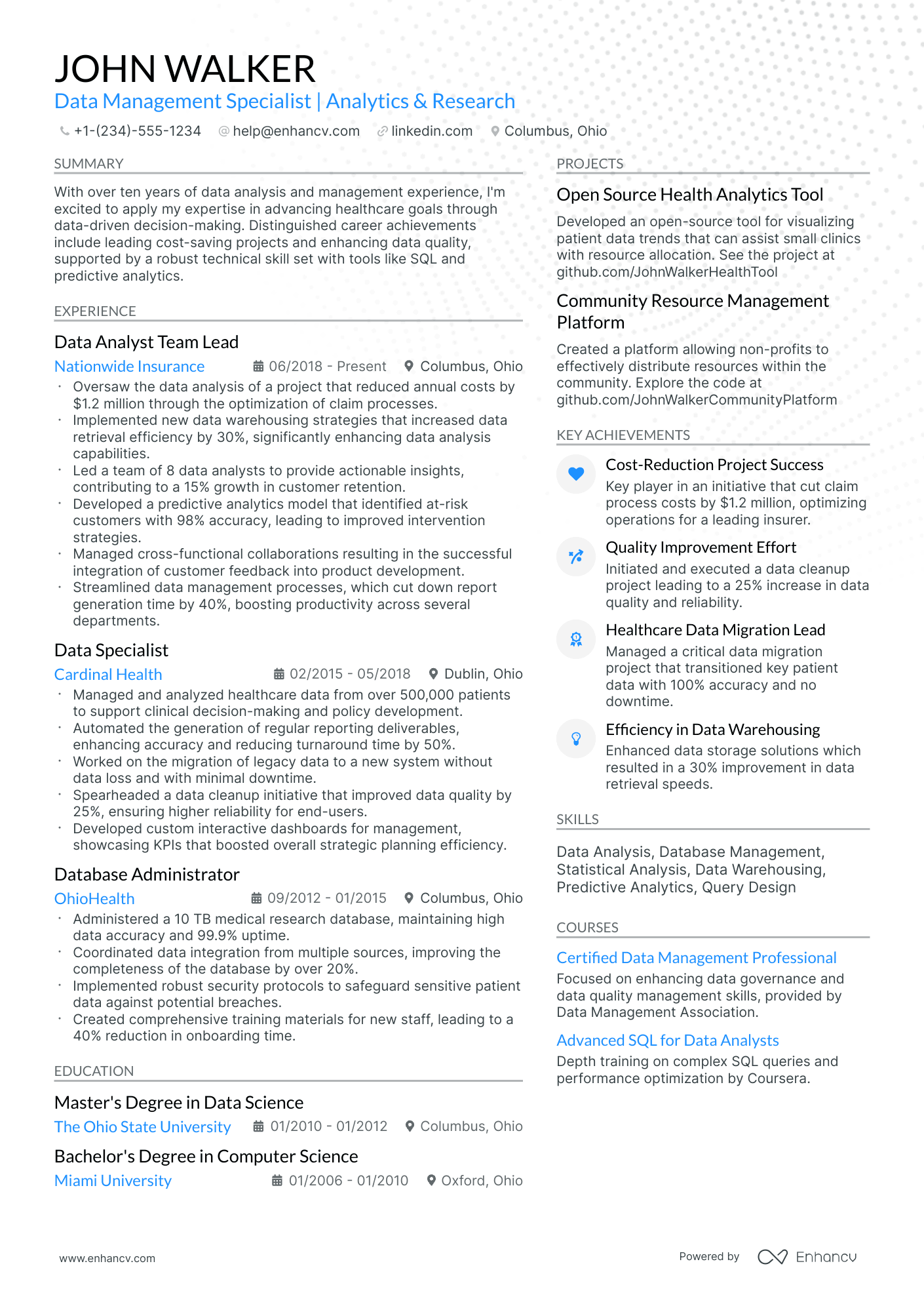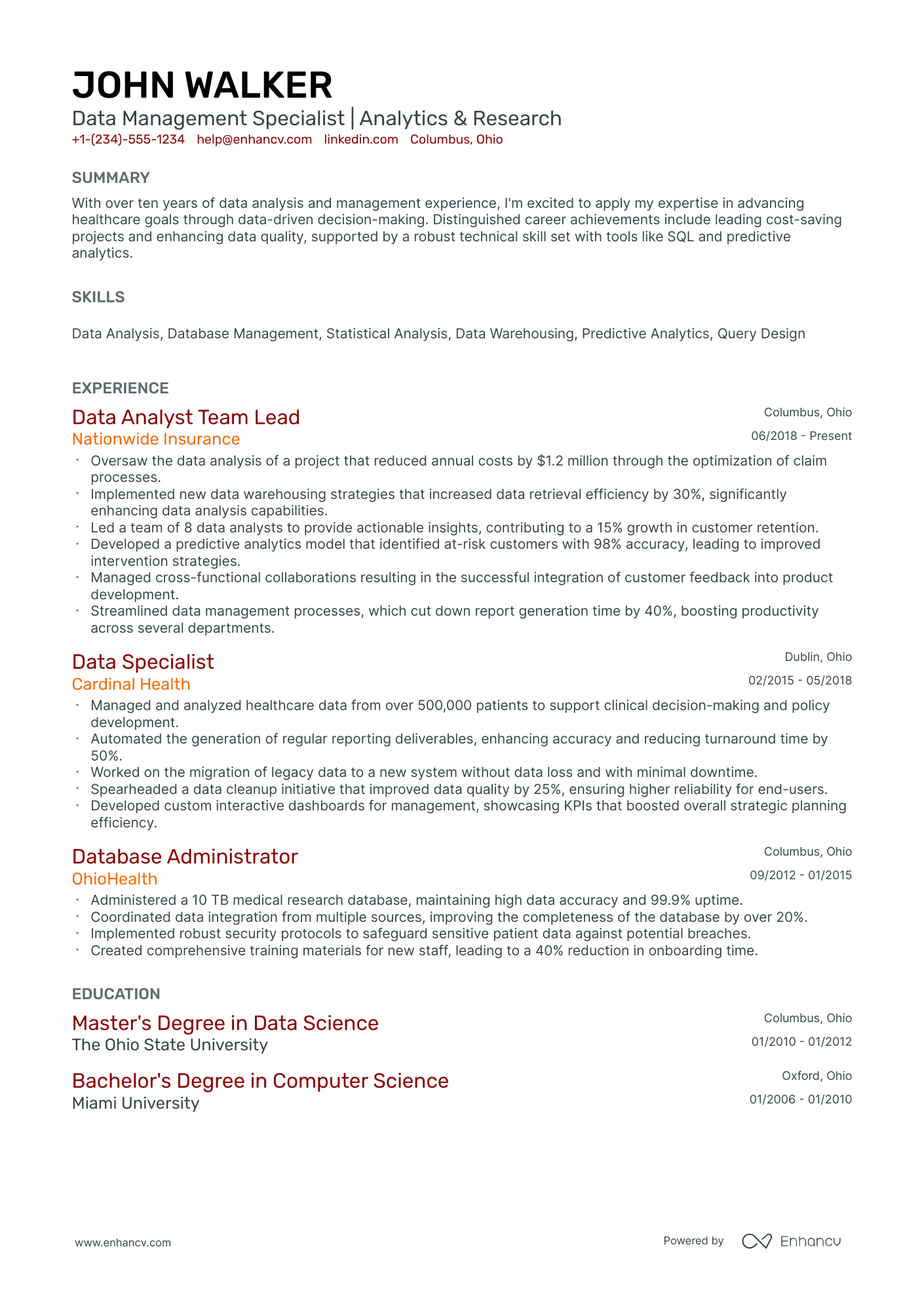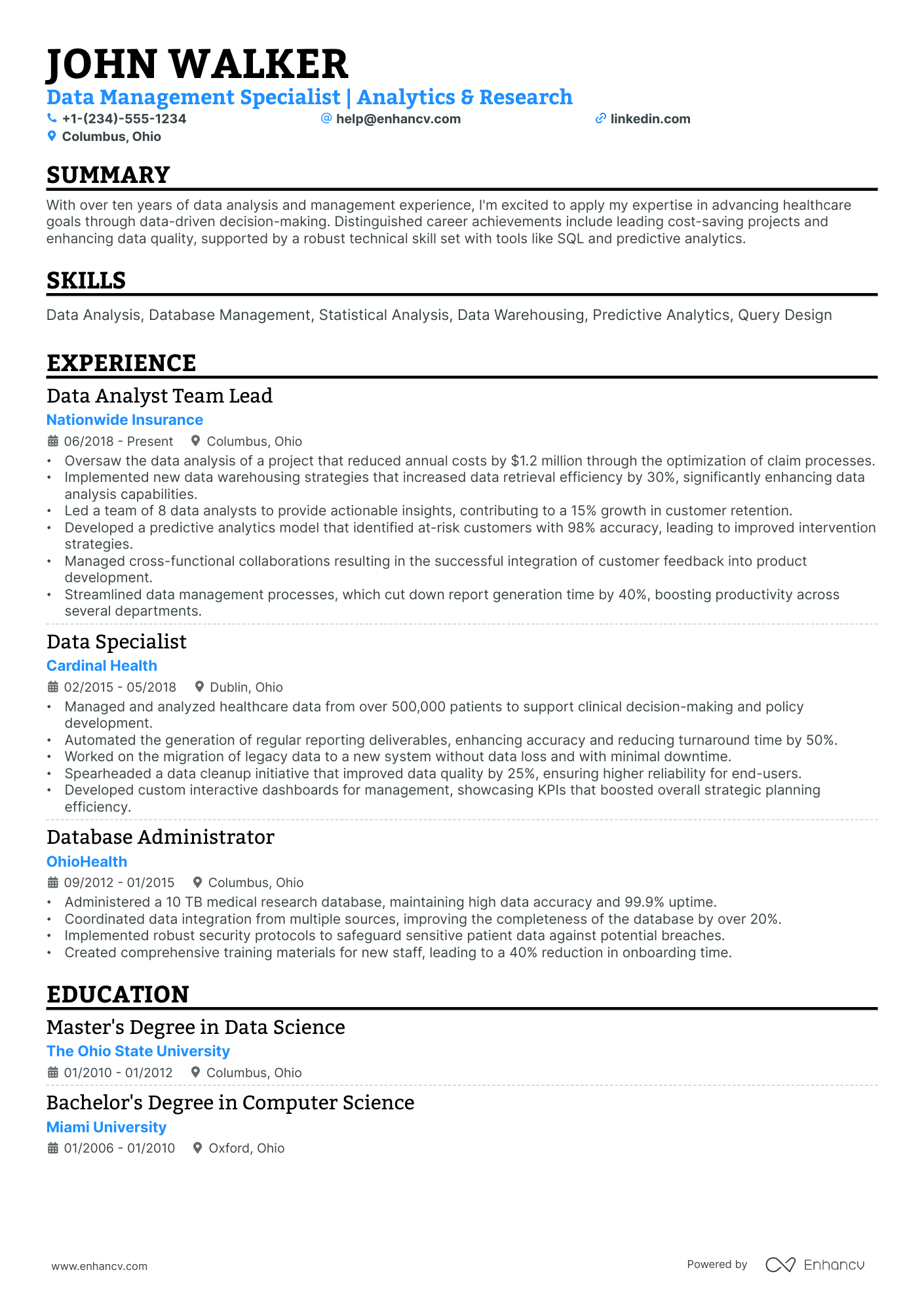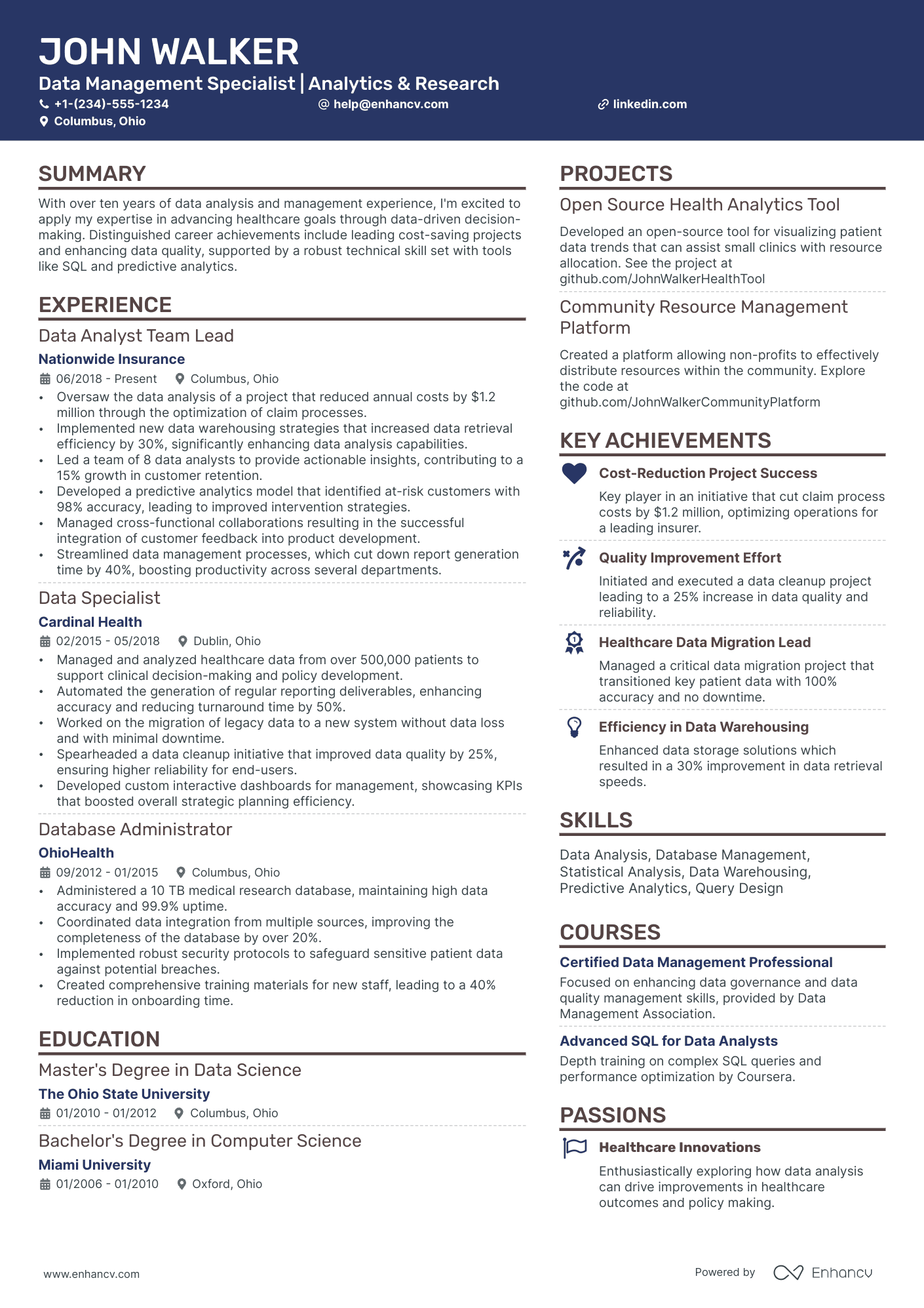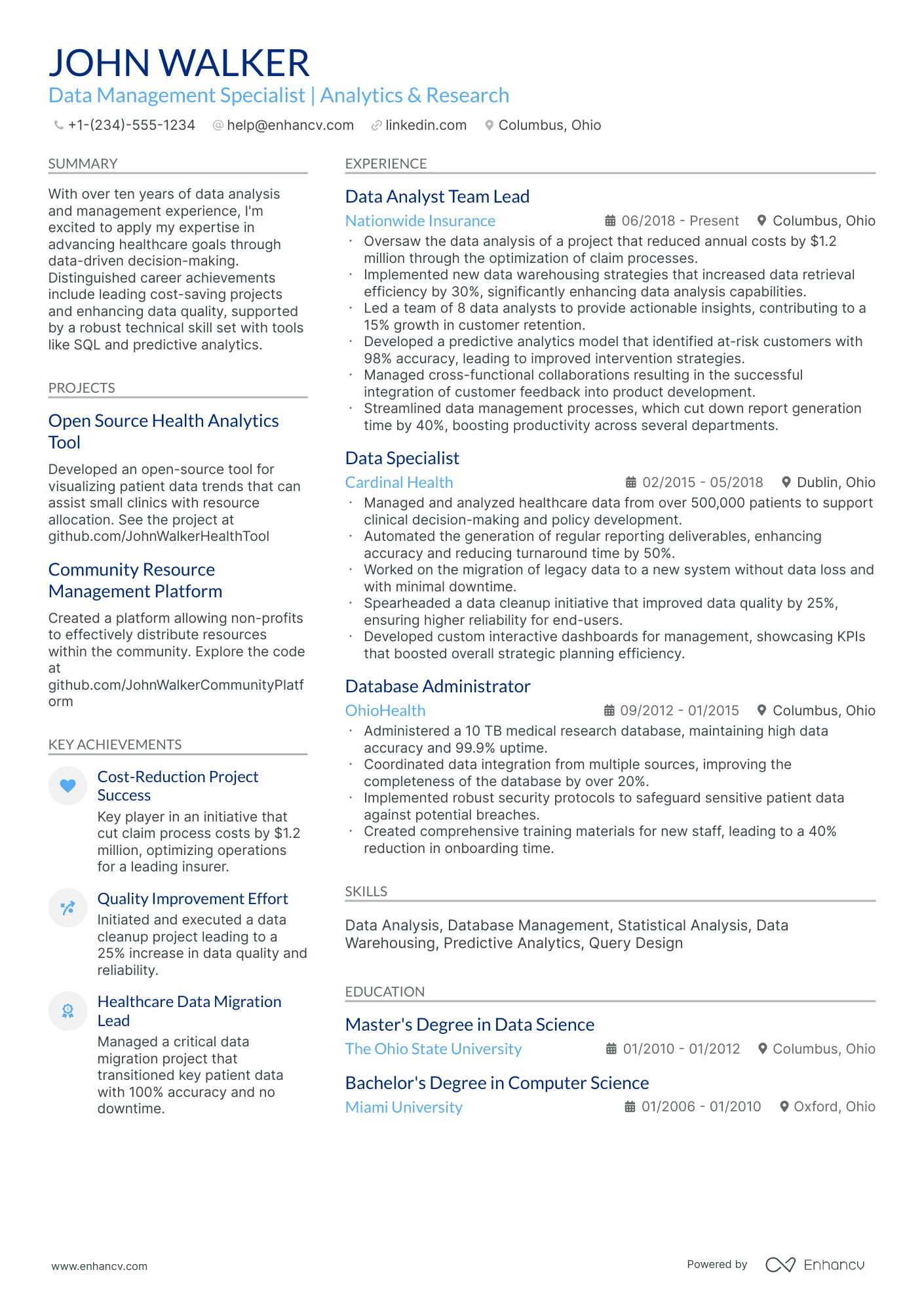As a data management analyst, you might struggle with effectively showcasing your complex technical skills and analytical achievements on a concise resume. Our guide will provide you with targeted advice to distill your expertise into clear, impactful language that will catch the eye of any recruiter.
- Format your data management analyst resume to ensure that it balances professionalism with creativity, and follows the best practices.
- Match the data management analyst job requirements by including industry keywords on your resume.
- Use various resume sections to showcase your skills and achievements to answer why you're the best candidate for the data management analyst role.
Take inspiration from leading data management analyst resume examples to learn how to tailor your experience.
- Database Engineer Resume Example
- Data Warehouse Engineer Resume Example
- Data Center Engineer Resume Example
- Data Manager Resume Example
- Data Reporting Analyst Resume Example
- Healthcare Data Analyst Resume Example
- Data Center Technician Resume Example
- Python Data Scientist Resume Example
- Data Entry Clerk Resume Example
- Database Architect Resume Example
Data management analyst resume format made simple
You don't need to go over the top when it comes to creativity in your data management analyst resume format .
What recruiters care about more is the legibility of your data management analyst resume, alongside the relevancy of your application to the role.
That's why we're presenting you with four simple steps that could help your professional presentation check all the right boxes:
- The reverse-chronological resume format is the one for you, if you happen to have plenty of relevant (and recent) professional experience you'd like to showcase. This format follows a pretty succinct logic and puts the focus on your experience.
- Keep your header simple with your contact details; a headline that details the role you're applying for or your current job; and a link to your portfolio.
- Ensure your resume reaches an up-to-two-page limit, only if you happen to be applying for a more senior role or you have over a decade of relevant experience.
- Save your data management analyst resume as a PDF to retain its structure and presentation.
Customize your resume for the market – a Canadian format, for example, might vary in structure.
Upload & Check Your Resume
Drop your resume here or choose a file. PDF & DOCX only. Max 2MB file size.
PRO TIP
Mention specific courses or projects that are pertinent to the job you're applying for.
The key to your data management analyst job-winning resume - present your expertise with these sections:
- A header to make your resume more scannable
- Snapshot of who you are as a professional with your resume soft skills, achievements, and summary or objective
- Job advert keywords in the skills section of your resume
- Resume experience quantifying your past job successes with metrics
- A relevant education, certification, and technical sills section to provide background to your technological/software capabilities
What recruiters want to see on your resume:
- Proficiency in data management software and tools, such as SQL, Excel, and data visualization platforms like Tableau or Power BI.
- Experience in data modeling, database design, and data warehousing principles.
- Knowledge of data governance, data quality management, and compliance with data protection regulations such as GDPR.
- Strong analytical skills with the ability to analyze large datasets, recognize patterns, and provide actionable insights.
- Experience in project management and cross-functional collaboration to ensure data accuracy and consistency across an organization.
Adding your relevant experience to your data management analyst resume
If you're looking for a way to show recruiters that your expertise is credible, look no further than the resume experience section.
Your data management analyst resume experience can be best curated in a structured, bulleted list detailing the particulars of your career:
- Always integrate metrics of success - what did you actually achieve in the role?
- Scan the data management analyst advert for your dream role in search of keywords in the job requirements - feature those all through your past/current experience;
- Dedicate a bullet (or two) to spotlight your technical capabilities and how you're able to use the particular software/technology in your day-to-day roles;
- Write simple by including your responsibility, a job advert keyword or skill, and a tangible outcome of your success;
- Use the experience section to also define the unique value of working with you in the form of soft skills, relevant feedback, and the company culture you best thrive in.
Industry leaders always ensure that their resume experience section offers an enticing glimpse at their expertise, while telling a career narrative. Explore these sample data management analyst resumes on how to best create your resume experience section.
- Spearheaded the data integrity initiative across marketing, sales, and customer support platforms, enhancing data quality by 40%.
- Developed and implemented a new data classification system, cutting down on unnecessary data storage costs by 15% annually.
- Led a cross-functional team to integrate a new CRM system, resulting in seamless data migration from three legacy systems.
- Managed the deployment of a company-wide data governance framework, ensuring regulatory compliance and improved data accessibility.
- Coordinated with IT to develop automated data cleaning processes, heightening data accuracy for critical decision-making by 30%.
- Executed a major database consolidation project, leading to a 20% reduction in operational overhead for data management.
- Pioneered the adoption of data visualization tools for the finance department, enhancing report comprehension and decision speed by 25%.
- Collaborated with data scientists to establish predictive analytics models, which increased sales forecast accuracy by 35%.
- Automated manual data entry processes, saving approximately 500 employee hours per year.
- Designed and monitored KPI dashboards for executive teams, delivering real-time insights that drove a revenue increase of 10% year-over-year.
- Initiated and managed a data quality project, which rectified over 100K erroneous records, enhancing customer engagement metrics.
- Orchestrated the transition to a new ETL tool, eliminating 90% of manual data manipulation tasks.
- Played a key role in developing an enterprise data warehouse, which consolidated data from 50+ sources and reduced report generation time by 75%.
- Conducted comprehensive data audits that identified and remediated over 250 data anomalies affecting customer data sets.
- Created a master data management protocol that was adopted enterprise-wide and improved data reuse across projects by 40%.
- Introduced a cloud-based data management platform, reducing data accessibility time for remote teams by 60% and fostering improved collaboration.
- Championed a data-centric culture change, which led to an organization-wide increase of data-driven decision-making in strategic planning.
- Developed a data compliance tracking system for GDPR and CCPA, which decreased compliance-related risks by 50%.
- Managed a large-scale data migration for a global merger, involving over 2TB of critical business data with zero downtime or data loss.
- Implemented a new data backup and recovery strategy, which reduced recovery time objectives by 70% and ensured business continuity.
- Cultivated a data stewardship program that improved data entry efficiency by 40%, eliminating nearly all manual data quality checks.
- Led the development and maintenance of an intricate data model that supported a 30% increase in operational productivity.
- Analyzed and streamlined data processing workflows, which resulted in a 20% acceleration of data availability for analytics purposes.
- Directed the implementation of data retention policies, ensuring compliance with industry standards and optimizing storage usage by 25%.
Quantifying impact on your resume
- Highlight the volume of data you've managed or analyzed, showcasing your ability to handle large datasets.
- Specify the number of databases you have designed or optimized to demonstrate technical expertise.
- Include the percentage of increased efficiency in data processing or reporting to show your impact on operations.
- Mention the precise number of data management projects you've led or contributed to, indicating your experience and leadership.
- Detail the amount of cost savings achieved through data analysis to illustrate your contribution to financial goals.
- Quantify any improvements in data quality or accuracy you've attained, to emphasize your attention to detail.
- Report the number of stakeholders you’ve supported with data-driven insights, proving your collaborative and communication skills.
- Indicate how many analytical tools or software you are proficient with, to show your technical versatility.
Action verbs for your data management analyst resume
No experience, no problem: writing your data management analyst resume
You're quite set on the data management analyst role of your dreams and think your application may add further value to your potential employers. Yet, you have no work experience . Here's how you can curate your resume to substitute your lack of experience:
- Don't list every single role you've had so far, but focus on ones that would align with the job you're applying for
- Include any valid experience in the field - whether it's at research or intern level
- Highlight the soft skills you'd bring about - those personality traits that have an added value to your application
- Focus on your education and certifications, if they make sense for the role.
Recommended reads:
PRO TIP
If you're in the process of obtaining your certificate or degree, list the expected date you're supposed to graduate or be certified.
Featuring your hard skills and soft skills on your data management analyst resume
The skills section of your data management analyst resume needs to your various capabilities that align with the job requirements. List hard skills (or technical skills) to showcase to potential employers that you're perfectly apt at dealing with technological innovations and niche software. Meanwhile, your soft skills need to detail how you'd thrive within your new, potential environment with personal skills (e.g. resilience, negotiation, organization, etc.) Your data management analyst resume skills section needs to include both types of skills to promote how you're both technical and cultural fit. Here's how to create your bespoke data management analyst skills section to help you stand out:
- Focus on skill requirements that are listed toward the top of the job advert.
- Include niche skills that you've worked hard to obtain.
- Select specific soft skills that match the company (or the department) culture.
- Cover some of the basic job requirements by including important skills for the data management analyst role - ones you haven't been able to list through the rest of your resume.
Get inspired with our data management analyst sample skill list to list some of the most prominent hard and soft skills across the field.
Top skills for your data management analyst resume:
SQL
Python
R
Excel
Tableau
Data Warehousing
ETL Tools
Data Modeling
Data Quality Management
Database Management Systems (DBMS)
Analytical Thinking
Problem Solving
Communication
Attention to Detail
Team Collaboration
Time Management
Adaptability
Critical Thinking
Organizational Skills
Interpersonal Skills
PRO TIP
The more time and effort you've put into obtaining the relevant certificate, the closer to the top it should be listed. This is especially important for more senior roles and if the company you're applying for is more forward-facing.
Maximizing your data management analyst resume: education and certification sections
To effectively showcase your industry knowledge in your data management analyst resume, it's important to properly list your education and certifications.
For the education section, ensure you include:
- Higher education degrees pertinent to the industry or those at a postgraduate level;
- The start and end dates of your education, along with the name of the institution you graduated from;
- Your GPA and relevant coursework, but only if they are impressive and applicable to the role.
Additionally, create a separate certifications section to spotlight your most notable recognitions. Another excellent place to feature a leading industry certificate is in your resume header, right after your name.
Below is a list of key industry certifications that are often sought after by recruiters
The top 5 certifications for your data management analyst resume:
- Certified Data Management Professional (CDMP) - Data Management Association International (DAMA International)
- Certified Information Management Professional (CIMP) - eLearningCurve
- IBM Certified Data Architect – Big Data (IBM Big Data Architect) - IBM
- Microsoft Certified: Data Analyst Associate (MCDAA) - Microsoft
- SAS Certified Big Data Professional (SAS Big Data Professional) - SAS Institute
PRO TIP
The more time and effort you've put into obtaining the relevant certificate, the closer to the top it should be listed. This is especially important for more senior roles and if the company you're applying for is more forward-facing.
Recommended reads:
Choosing between a data management analyst resume summary or objective
Many may argue that, in recent times, the data management analyst resume summary or objective has become completely obsolete.
But the reality is different as both of these resume sections provide you with an opportunity to :
- integrate data management analyst-vital keywords
- showcase your accomplishments
- answer why you're applying for this particular role.
The difference (between the summary and the objective) is that the:
- Resume objective puts your career goals in a more prominent position.
- Resume summary focuses more on career milestones.
We recommend you select the summary if you happen to have plenty of experience you'd like to spotlight from the very start of your data management analyst resume.
Meanwhile, the objective is ideal for those candidates who'd like to further prove their suitability for the role with their goals and soft skills.
We've featured some industry professional data management analyst resume samples to the best resume summary and objective structures:
Resume summaries for a data management analyst job
- With over 8 years of expertise in data management for high-volume financial firms, I bring a proven track record in database optimization and mastery of SQL and NoSQL technologies. Awarded ‘Analyst of the Year’ for significantly increasing data processing speeds by 40% at Globex Corporation, I aspire to leverage my analytical proficiency and innovative solutions to transform data ecosystems.
- Renowned for a keen eye for detail and a passion for analytics, my 6 years as a seasoned data analyst has involved managing large datasets, implementing robust ETL pipelines, and conducting complex statistical analyses using R and Python at TechGiant Solutions with a consistent record of improving data accuracy by over 30%.
- Transitioning from a 5-year tenure in academic research, I am equipped with a strong foundation in statistical analysis and expertise in research methodologies. I seek to apply this knowledge to the realm of data management by engaging with new technologies like machine learning to drive evidence-based decision-making in a dynamic commercial environment.
- As a professional with extensive experience in supply chain optimization, I am adept at analyzing market trends and streamlining operations. My skills in logistics management and proficiency with BI tools like Tableau are now being directed towards a career in data management to optimize data-driven strategies in competitive industries.
- Keen to embark on a career in data management, I bring a fresh perspective bolstered by a strong analytical background from my studies in Information Technology. Eager to contribute and grow, my objective is to develop tactical data governance strategies that enable businesses to thrive on reliable and actionable insights.
- With a newfound passion for data and recent certification in Data Analytics, my ambition is to merge my enthusiasm for technology with practical skills in SQL, Python, and data visualization. I am driven to pursue a role where I can contribute to impactful data management projects while expanding my knowledge in a hands-on setting.
Optimize your resume summary and objective for ATS
Drop your resume here or choose a file.
PDF & DOCX only. Max 2MB file size.
Four more sections for your data management analyst resume
Your data management analyst resume can be supplemented with other sections to highlight both your personality and efforts in the industry. Use the ones you deem most relevant to your experience (and the role):
- Awards - to celebrate your success;
- Interests - to detail what you're passionate about outside of work (e.g. music, literature, etc.);
- Publications - to show your footprint in the wider community;
- Projects - to pinpoint noteworthy achievements, potentially even outside of work.
Key takeaways
- Ensure your data management analyst resume uses a simple, easy-to-read format that reflects upon your experience and aligns with the role;
- Be specific within the top one-third of your resume (header and summary or objective) to pinpoint what makes you the ideal candidate for the data management analyst role;
- Curate information that is tailored to the job by detailing skills, achievements, and actual outcomes of your efforts;
- List your certifications and technical capabilities to demonstrate your aptitude with specific software and technologies;
- The sections you decide on including on your data management analyst should pinpoint your professional expertise and personality.
